In today’s fast-paced world, remote communication has become the new norm. Whether you’re working from home, conducting virtual meetings, or connecting with friends and family from afar, having the right video conferencing software is essential. Zoom has undoubtedly been a game-changer in this regard, but what if you’re looking for alternatives that offer unique features or better suit your specific needs? In this comprehensive guide, we’ll dive into 10 top-notch Zoom alternatives that can elevate your remote communication experience. From high-quality video calls to innovative collaboration tools, we’ve got you covered.
1. Microsoft Teams: The Powerhouse of Collaboration
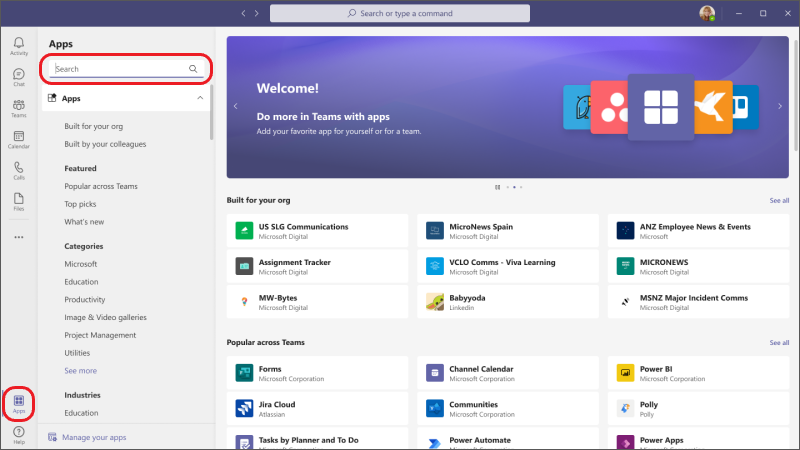
Microsoft Teams is more than just a video conferencing tool; it’s a full-fledged collaboration hub. It seamlessly integrates with Microsoft 365, making it a go-to choice for businesses heavily reliant on Microsoft products. Want to share documents, collaborate on projects, or conduct video calls? Microsoft Teams has you covered.
Pros:
- Integration with Microsoft 365: Microsoft Teams seamlessly integrates with other Microsoft 365 apps like Word, Excel, and PowerPoint. This makes it a powerful choice for businesses already using these tools, as it streamlines collaboration and document sharing.
- Wide Range of Features: Microsoft Teams offers a comprehensive suite of features, including chat, video conferencing, file sharing, screen sharing, and the ability to create and manage teams and channels. It’s a one-stop-shop for all your team’s communication and collaboration needs.
- Security and Compliance: Microsoft takes security seriously, and Teams benefits from the robust security measures of Microsoft 365. It offers end-to-end encryption, multi-factor authentication, and compliance with various industry standards, making it suitable for businesses with stringent security requirements.
Cons:
- Learning Curve: While Microsoft Teams is feature-rich, its wide array of options can be overwhelming for new users. It may take some time for team members to become proficient in using all the available tools.
- Resource Intensive: Running Microsoft Teams, especially in larger organizations, can be resource-intensive. It may require a robust IT infrastructure and ample bandwidth to ensure a smooth experience, which can be costly.
- Notification Overload: Teams can generate a lot of notifications, leading to potential distraction and information overload. Users may need to fine-tune their notification settings to manage this effectively.
2. Google Meet: Simple, Reliable, and Free

Google Meet, formerly known as Google Hangouts Meet, is known for its simplicity and reliability. It’s an excellent choice for those already entrenched in the Google ecosystem. With its integration with Google Calendar and Gmail, scheduling and joining meetings is a breeze. Plus, it offers a free tier with many useful features.
Pros:
- Integration with Google Workspace: Google Meet seamlessly integrates with other Google Workspace (formerly G Suite) apps like Google Calendar and Gmail. This makes scheduling and joining meetings convenient for users already using Google’s ecosystem.
- User-Friendly Interface: Google Meet boasts a clean and intuitive interface that is easy to navigate, making it accessible to both beginners and experienced users.
- High-Quality Video and Audio: Google Meet offers reliable video and audio quality, ensuring that your meetings and presentations are clear and professional.
- Screen Sharing: Users can easily share their screens during meetings, making it ideal for collaborative work, presentations, and demonstrations.
- Live Captioning: Google Meet provides live captioning, which can be a valuable feature for individuals with hearing impairments or for participants in noisy environments.
Cons:
- Limited Free Version: While Google Meet does offer a free version, it comes with limitations, such as a maximum meeting duration and a limited number of participants. Some advanced features are only available in paid plans.
- Privacy Concerns: Like many online platforms, Google Meet has faced privacy concerns in the past. Users may be concerned about data collection and privacy issues, especially if using the free version.
- Meeting Organization: While integration with Google Calendar is a benefit, some users may find it challenging to organize and manage meetings, particularly in large organizations.
- Lack of Advanced Features: Compared to some other video conferencing platforms, Google Meet may lack advanced features like breakout rooms and virtual backgrounds. These features are important for specific use cases.
- Dependency on Internet Speed: A stable and high-speed internet connection is essential for a smooth experience with Google Meet. Users with slow or unreliable internet connections may face issues during meetings.
3. Cisco Webex: Ideal for Large Meetings
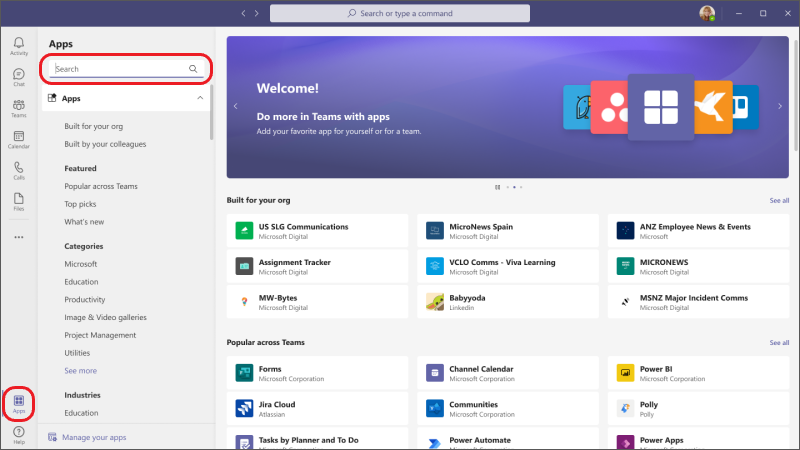
Cisco Webex is a robust platform designed to handle large-scale meetings and webinars. With features like breakout rooms, whiteboarding, and real-time translation, it’s a versatile option. Not to mention, it boasts impressive security measures to keep your conversations confidential.
Pros:
- Robust Features: Cisco Webex offers a wide range of features, including screen sharing, breakout rooms, whiteboarding, file sharing, and real-time chat. It’s suitable for various meeting types, from small team collaborations to large webinars.
- Large Meeting Capacity: Webex is designed to handle large-scale meetings and webinars, accommodating hundreds or even thousands of participants, making it ideal for organizations with extensive virtual communication needs.
- Security: Cisco Webex places a strong emphasis on security, with features like end-to-end encryption, meeting passwords, and the ability to lock meetings once they start. This helps ensure the privacy and confidentiality of your conversations.
- Integration: It seamlessly integrates with other Cisco collaboration tools and third-party apps, enhancing productivity and making it a valuable addition to existing tech stacks.
Cons:
- Complexity: While Cisco Webex offers a wealth of features, its extensive capabilities can be overwhelming for new users. The interface may not be as intuitive as some other video conferencing tools, which may require a learning curve.
- Cost: While there is a free version of Webex, the premium features and large meeting capacities come with a cost. For organizations with budget constraints, this can be a drawback.
- Resource Intensive: Running Webex can be resource-intensive, particularly for hosts and participants using older hardware or slower internet connections. This can lead to performance issues, such as lag or dropped calls.
- Meeting Joining Process: Joining a Webex meeting can sometimes be cumbersome for participants who are not familiar with the platform. They may need to download and install the Webex app or browser extension, which can be time-consuming.
4. BlueJeans: A High-Definition Experience
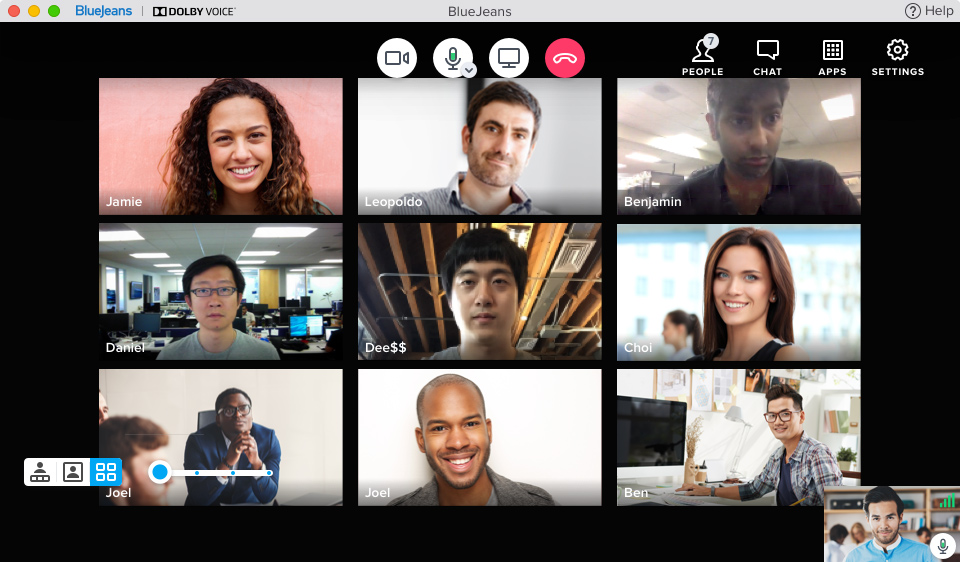
If high-definition video and audio quality are your top priorities, BlueJeans might be your ideal Zoom alternative. It offers exceptional audio and video clarity, making it perfect for important business meetings and presentations.
Pros:
- High-Quality Video and Audio: BlueJeans is known for its exceptional video and audio quality. It offers high-definition video streaming and crystal-clear audio, making it ideal for important business meetings and presentations.
- Cross-Platform Compatibility: BlueJeans can be accessed from various devices and operating systems, including Windows, macOS, iOS, Android, and web browsers, ensuring that participants can join meetings from their preferred platforms.
- Integration: It seamlessly integrates with popular productivity and collaboration tools such as Microsoft Teams, Slack, Trello, and more, enhancing your workflow efficiency.
- Recording and Playback: BlueJeans allows users to record meetings and webinars, making it convenient for those who need to review discussions or share them with others who couldn’t attend in real-time.
Cons:
- Pricing: BlueJeans can be relatively expensive for small businesses or individuals compared to some other video conferencing options that offer free or lower-cost plans.
- Complexity: While BlueJeans offers advanced features, it may have a steeper learning curve for some users, especially those new to video conferencing platforms.
- Limited Free Plan: Unlike some competitors, BlueJeans doesn’t offer a free plan with unlimited usage, which may deter users looking for a cost-free solution for small meetings.
- Fewer Participant Options: Some video conferencing platforms allow a larger number of participants in a single meeting compared to BlueJeans, which might be limiting for very large virtual gatherings.
- Competition: The video conferencing market is highly competitive, with several strong contenders, which means that BlueJeans faces stiff competition from well-established players like Zoom, Microsoft Teams, and Google Meet.
5. Slack: The Chat-Centric Choice
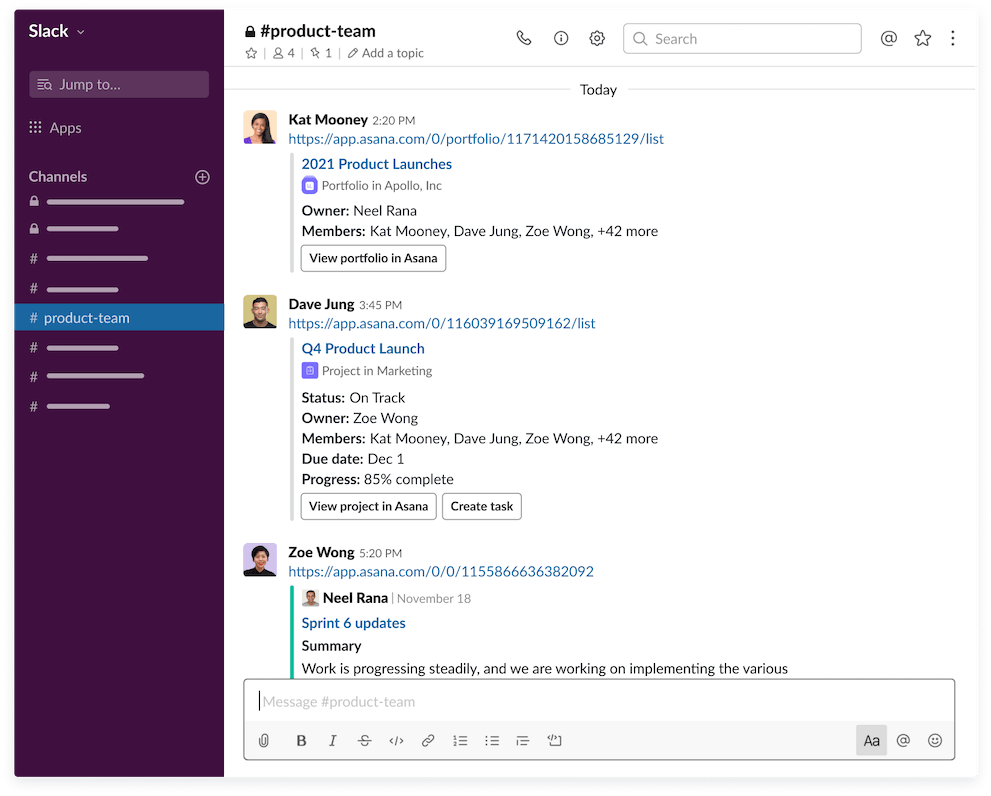
While Slack is primarily known as a messaging app, it also offers a robust video calling feature. If you value quick, real-time communication and seamless integration with various apps and services, Slack might be your go-to Zoom alternative.
Pros:
- Efficient Communication: Slack provides real-time messaging, allowing team members to communicate quickly and efficiently. It reduces the need for lengthy email threads.
- Integration Capabilities: Slack offers a wide range of integrations with other tools and services, such as Google Drive, Trello, and GitHub, making it a central hub for workflow management.
- File Sharing: Users can easily share files, documents, images, and other media within Slack, making it convenient for collaboration and knowledge sharing.
- Customization: Slack allows users to create channels for different topics, teams, or projects, enabling organized discussions. Users can also customize notification preferences for each channel.
Cons:
- Notification Overload: Users may experience notification fatigue due to constant updates, especially in active channels. Customizing notifications can help, but it requires manual adjustments.
- Steep Learning Curve: Slack’s rich feature set can be overwhelming for new users, and it may take time to learn and navigate all the functionalities effectively.
- Costs: While Slack offers a free version, more advanced features, integrations, and larger teams often require a paid subscription, which can be costly for some businesses.
- Fragmented Conversations: In large teams or channels, conversations can become fragmented and challenging to follow, leading to misunderstandings or missed messages.
6. GoToMeeting: Designed for Professionalism
GoToMeeting is tailored for businesses seeking a professional video conferencing solution. It offers features like drawing tools, meeting analytics, and the ability to schedule meetings in advance. If you’re looking for a polished and reliable platform, GoToMeeting is worth considering.
Pros:
- Ease of Use: GoToMeeting is known for its user-friendly interface, making it accessible even to those with limited technical expertise. Setting up and joining meetings is straightforward.
- Reliability: The platform is renowned for its reliability and stability, ensuring that meetings run smoothly without interruptions.
- Cross-Platform Compatibility: GoToMeeting supports various operating systems, including Windows, macOS, iOS, and Android, making it versatile for users across different devices.
Cons:
- Cost: While GoToMeeting offers a free trial, its paid plans can be relatively expensive compared to some competitors, potentially making it less accessible for small businesses or individuals.
- Limited Free Features: The free version of GoToMeeting has limited features, and some essential functionalities may require a subscription.
- Participant Limit: Depending on your subscription, there may be a participant limit for meetings, which can be a drawback for larger gatherings.
- Advanced Features: Some advanced features like transcription services or in-room hardware integrations may not be as comprehensive as those offered by competitors.
7. Jitsi Meet: Open Source and Secure
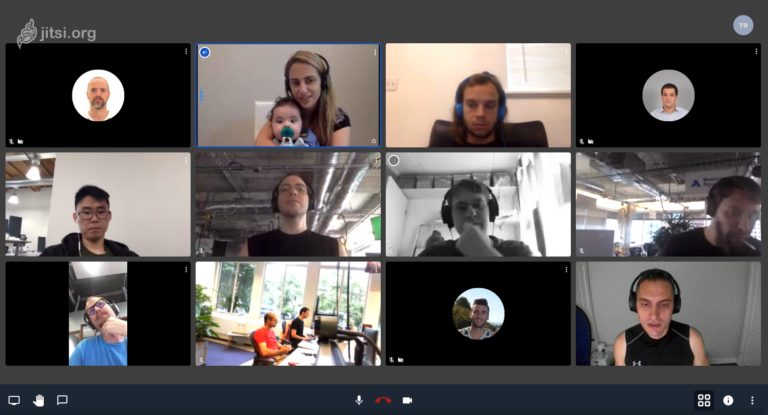
If privacy and security are paramount for you, Jitsi Meet is an open-source video conferencing tool that won’t disappoint. It’s designed with end-to-end encryption in mind, ensuring your conversations stay private. Plus, it’s completely free to use.
Pros:
- Open Source: Jitsi Meet is open-source software, which means it’s freely available for anyone to use and modify. This transparency can enhance trust and security.
- End-to-End Encryption: Jitsi Meet offers end-to-end encryption for audio and video calls, ensuring that your conversations are private and secure.
- No Registration Required: You can use Jitsi Meet without having to create an account or provide personal information, offering a more anonymous option for meetings.
- Web-Based: Jitsi Meet is accessible directly from your web browser, eliminating the need for participants to download and install software or apps.
- Multi-Platform Support: It’s compatible with various platforms, including Windows, macOS, Linux, Android, and iOS, making it accessible to a wide range of users.
Cons:
- Limited Features: While Jitsi Meet offers essential video conferencing features, it may lack some advanced functionalities found in more established platforms like Zoom or Microsoft Teams.
- Scalability: It may not be the best choice for very large meetings or webinars, as performance could degrade with a high number of participants.
- User Interface: Some users find the user interface less intuitive compared to other video conferencing tools, which may require a learning curve for new users.
8. Zoho Meeting: Streamlined and Feature-Rich

Zoho Meeting offers a user-friendly interface and a host of features for seamless remote collaboration. It includes options for webinars, screen sharing, and recording meetings. If you value simplicity combined with robust functionality, Zoho Meeting is worth a try.
Pros:
- User-Friendly Interface: Zoho Meeting offers an intuitive and user-friendly interface, making it easy for both hosts and participants to navigate and use the platform effectively.
- Affordable Pricing: Zoho Meeting provides cost-effective plans, including a free plan with limited features and competitive pricing for its premium plans, making it accessible for individuals and small businesses.
- Browser-Based: Participants can join meetings directly from their web browsers, eliminating the need to download and install software, which streamlines the onboarding process.
Cons:
- Limited Features in Free Plan: While Zoho Meeting offers a free plan, it comes with limitations, such as a maximum of two participants and a 10-minute meeting duration. This may not be sufficient for some users.
- Limited Branding Customization: The level of branding customization in Zoho Meeting is limited compared to some other video conferencing platforms, which might be a drawback for businesses looking for a highly branded experience.
- No Virtual Backgrounds: Unlike some competitors, Zoho Meeting does not offer virtual background options, which can be a fun and useful feature for personalization during video calls.
9. Webex Meetings: A Pocket-Sized Solution
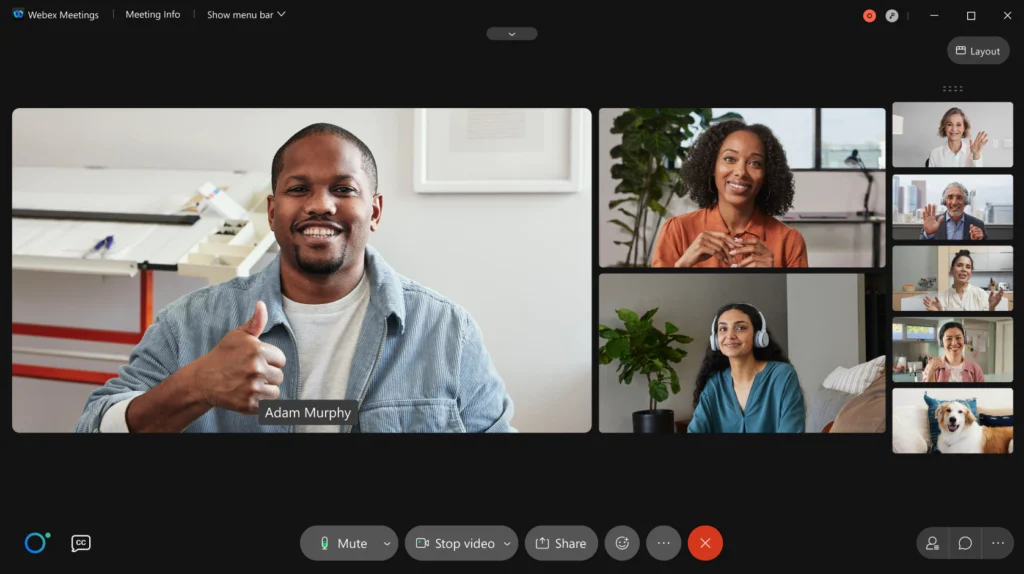
Webex Meetings, the mobile counterpart of Cisco Webex, brings the power of video conferencing to your smartphone or tablet. It’s perfect for those on the go or anyone looking for a convenient mobile solution without compromising on features.
Pros:
- Reliable Performance: Webex Meetings is known for its stability and reliability, making it a dependable choice for important business meetings.
- High-Quality Video and Audio: It offers high-definition video and crystal-clear audio quality, enhancing the overall meeting experience.
- Large Meeting Support: Webex Meetings can accommodate a large number of participants, making it suitable for webinars, seminars, and conferences.
- Security Features: Cisco, the company behind Webex, places a strong emphasis on security. It offers end-to-end encryption, secure meeting rooms, and various security controls.
Cons:
- Cost: While it offers a free tier, some of the more advanced features are available only in paid plans, which can be relatively expensive for businesses.
- Complex Interface: Some users find the interface to be somewhat complex and less intuitive compared to some competitors like Zoom and Google Meet.
- Resource Intensive: Running Webex Meetings can be resource-intensive on your device, which may lead to performance issues on older or less powerful computers.
10. RingCentral Video: All-in-One Communications

RingCentral Video combines video conferencing with team messaging, file sharing, and task management. It’s a comprehensive solution for businesses seeking an all-in-one communications platform. With integrations for popular productivity tools, it streamlines your workflow.
Pros:
- All-in-One Solution: RingCentral Video offers a comprehensive package that combines video conferencing, team messaging, file sharing, and task management in a single platform. This integration streamlines communication and collaboration, reducing the need for multiple tools.
- User-Friendly Interface: The platform boasts an intuitive and user-friendly interface, making it easy for both beginners and experienced users to navigate and use effectively.
- Quality Video and Audio: RingCentral Video provides high-quality video and audio, ensuring that your virtual meetings are clear and efficient. This is crucial for productive discussions and presentations.
Cons:
- Cost: While it offers a free plan with limited features, the more advanced features and capabilities of RingCentral Video come with a price tag. This can be a drawback for budget-conscious individuals or small businesses.
- Learning Curve: Despite its user-friendly interface, some users might find it challenging to explore all the features and settings initially, which could result in a learning curve.
- Limited Free Plan: The free plan has limitations in terms of the number of participants and meeting duration. This might not be suitable for larger teams or lengthy meetings.
Conclusion: Expanding Your Communication Horizons
In today’s world, having a versatile toolkit for remote communication is essential. While Zoom remains a reliable option, exploring alternatives can uncover hidden gems tailored to your unique needs. Whether it’s Microsoft Teams’ collaborative prowess, Google Meet’s simplicity, or the security of Jitsi Meet, these Zoom alternatives are here to enhance your remote communication experience.

David’s journey in the tech world began as a system administrator and he has since transitioned to a new IT role in a different company. Over the years, his extensive knowledge and practical experience have made him a trusted go-to resource for friends and acquaintances seeking help with computer-related issues. Recognizing the value of his accumulated knowledge, David transformed his initial idea of a personal blog into a platform aimed at helping others.
He takes pride in crafting detailed and user-friendly articles and guides, ensuring that even novice computer users can benefit from his insights.
Send your message for David here and learn more about him.

